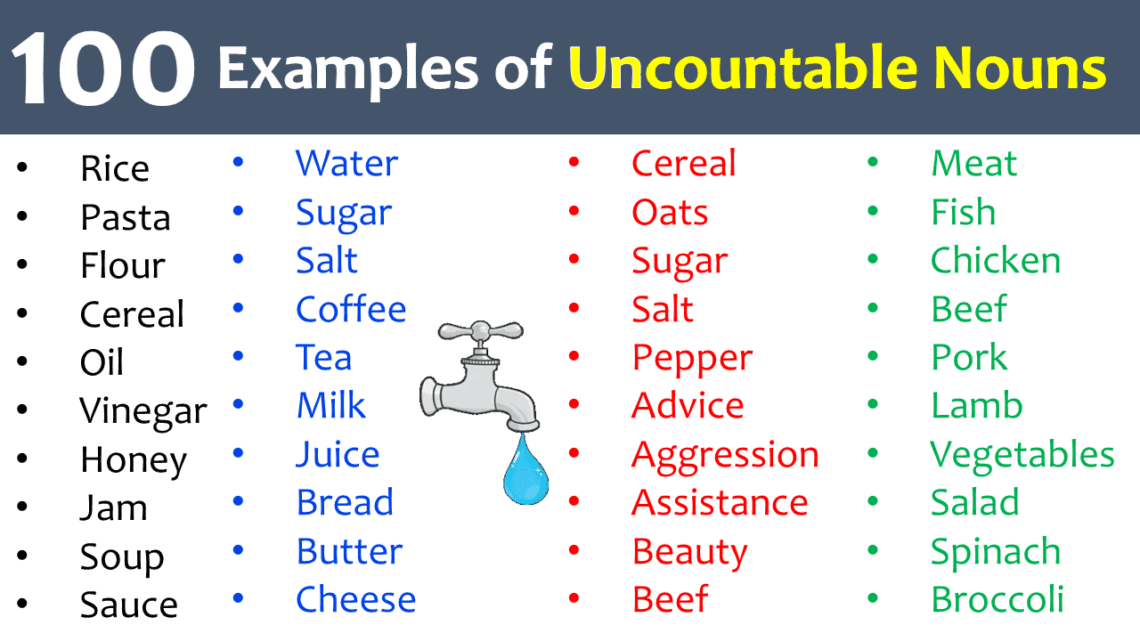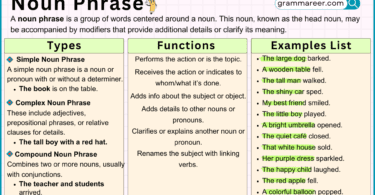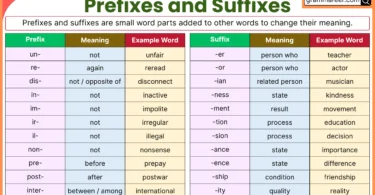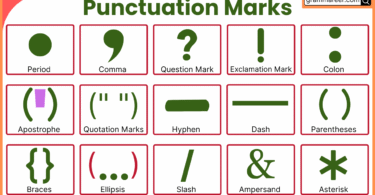Understanding uncountable nouns is essential for improving English grammar. These nouns refer to things that cannot be counted individually, such as liquids, emotions, or abstract ideas. Unlike countable nouns, they do not have a plural form and require specific quantifiers for measurement. Many learners struggle with their correct usage in sentences, leading to common mistakes in writing and speaking. In this blog post, we will provide 100 examples of uncountable nouns to help you master their usage. To enhance your knowledge, visit our grammar section for more detailed explanations.
Table of Contents
What are Uncountable Nouns?
Uncountable nouns, also known as mass nouns or non-count nouns, are words that represent substances, concepts, or qualities that cannot be counted as separate units. They are things that we can’t say “one,” “two,” or “three” of. Uncountable nouns refer to something that is seen as a whole or a mass, without a specific quantity. For example, we can say “one apple” or “two apples,” but we can’t say “one water” or “two waters” because water is an uncountable noun.
Here are a few more examples of uncountable nouns:
- Sugar: We can’t count sugar in individual pieces or units.
- Salt: We can’t count salt as separate grains.
- Information: We can’t count information as individual pieces.
- Advice: We can’t count advice as separate items.
Uncountable nouns are often used with a singular verb and are not preceded by “a” or “an” because they don’t refer to one specific item. Instead, we use words like “some” or “a lot of” to indicate an unspecified amount.
It’s important to remember that uncountable nouns are not plural and don’t have a singular/plural distinction. They represent things that are considered as a whole or cannot be easily separated into individual parts.
Understanding uncountable nouns helps us use appropriate grammar, choose the right verb forms, and communicate effectively in English.
100 Examples of Uncountable Nouns
- Water
- Sugar
- Salt
- Coffee
- Tea
- Milk
- Juice
- Bread
- Butter
- Cheese
- Rice
- Pasta
- Flour
- Cereal
- Oil
- Vinegar
- Honey
- Jam
- Soup
- Sauce
- Gravy
- Yogurt
- Ice cream
- Chocolate
- Fruit
- Meat
- Fish
- Chicken
- Beef
- Pork
- Lamb
- Advice
- Aggression
- Assistance
- Beauty
- Beef
- Bravery
- Bread
- Butter
- Cake
- Cash
- Chaos
- Clothing
- Confidence
- Rice
- Cereal
- Oats
- Sugar
- Salt
- Pepper
- Spice
- Herbs
- Vinegar
- Mustard
- Ketchup
- Mayonnaise
- Chocolate
- Coffee
- Tea
- Milk
- Cream
- Yogurt
- Ice cream
- Butter
- Cheese
- Bread
- Cake
- Biscuits
- Cookies
- Pie
- Pizza
- Pasta
- Rice
- Cereal
- Soup
- Noodles
- Flour
- Dough
- Cinnamon
- Nutmeg
- Basil
- Oregano
- Parsley
- Saltwater
- Freshwater
- Rain
- Snow
- Sand
- Air
- Dust
- Gold
- Silver
- Platinum
- Copper
- Iron
- Steel
- Plastic
- Glass
- Wood
- Paper
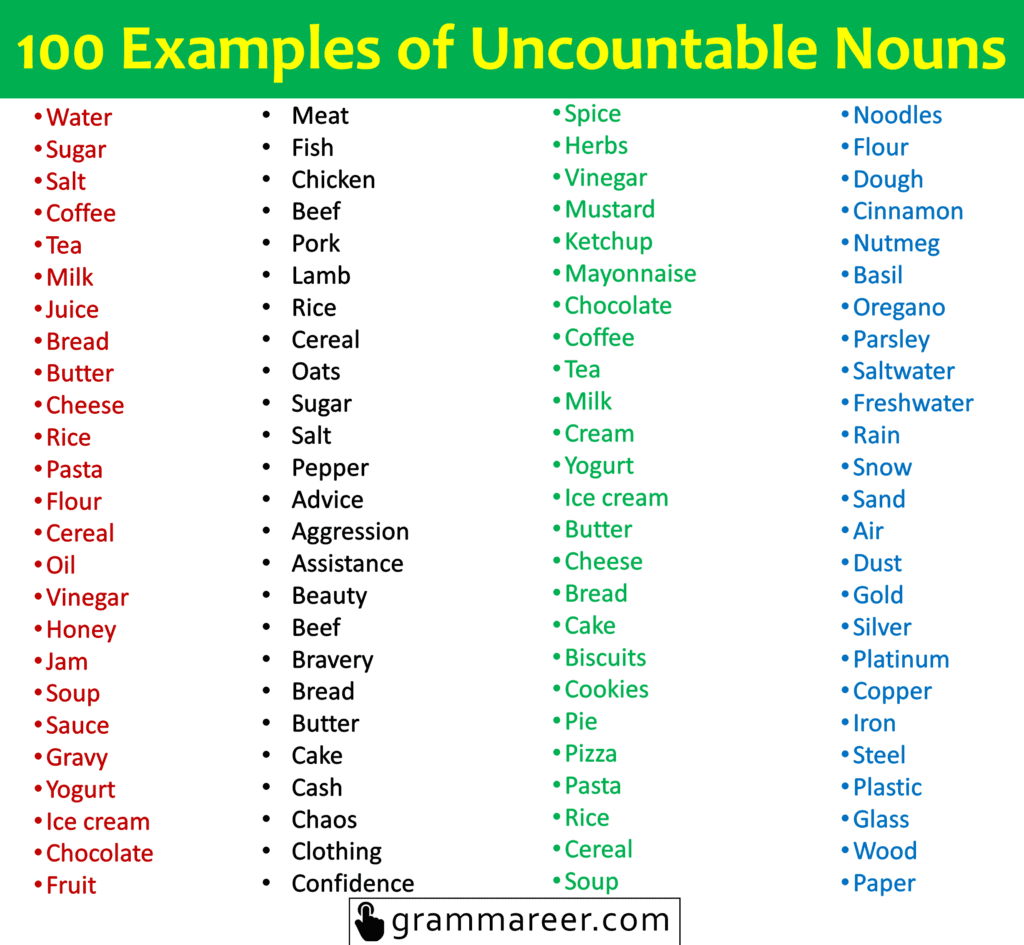
100 Examples of Uncountable Nouns in Sentences
- Water: Essential liquid for drinking and hydration.
- Sugar: Sweet substance used to add sweetness to food and beverages.
- Salt: Common seasoning used to enhance the flavor of dishes.
- Coffee: Popular hot beverage made from roasted coffee beans.
- Tea: Hot or cold beverage made from steeping leaves of the tea plant.
- Milk: White liquid produced by mammals used as a drink and ingredient.
- Juice: Liquid extracted from fruits or vegetables, often consumed for its flavor and nutrients.
- Bread: Staple food made from flour, water, and yeast, often used for sandwiches.
- Butter: Spreadable dairy product made from cream, commonly used in cooking and baking.
- Cheese: Solid food made from the curdled milk of animals, available in various flavors and textures.
- Rice: Staple grain consumed worldwide, commonly served as a side dish or in dishes like stir-fries.
- Pasta: Food made from unleavened dough of wheat flour, often served with sauce.
- Flour: Powder obtained from grinding grains, used in baking and cooking.
- Cereal: Breakfast food made from grains, often served with milk.
- Oil: Liquid fat extracted from plants or animals, used for cooking and flavoring.
- Vinegar: Sour liquid made through fermentation, used in cooking and dressings.
- Honey: Sweet, viscous substance produced by bees from flower nectar.
- Jam: Sweet spread made by boiling fruits with sugar, often enjoyed on bread.
- Soup: Liquid dish made by combining ingredients like meat and vegetables, often served hot.
- Sauce: Liquid or semi-solid condiment used to add flavor to dishes.
- Gravy: Sauce made from the juices of cooked meat, often served with roast or mashed potatoes.
- Yogurt: Dairy product produced by bacterial fermentation of milk, often eaten as a snack or dessert.
- Ice cream: Frozen dessert made from sweetened and flavored cream or milk.
- Chocolate: Sweet treat made from cocoa beans, often used in confectionery.
- Fruit: Edible, sweet, and fleshy product of plants, such as apples, oranges, or bananas.
- Meat: Animal flesh used as food, such as beef, pork, or chicken.
- Fish: Aquatic animal consumed as food, often with a distinct flavor.
- Chicken: Domestic bird commonly consumed for its meat.
- Beef: Meat from cattle, often used in dishes like steaks or burgers.
- Pork: Meat from pigs, used in various culinary preparations.
- Lamb: Meat from young sheep, appreciated for its tenderness and flavor.
- Vegetables: Edible plants, such as carrots, broccoli, or potatoes, commonly consumed for their nutrients.
- Salad: Mixture of vegetables and other ingredients served cold.
- Spinach: Leafy green vegetable often used in salads or cooked dishes.
- Broccoli: Green vegetable with a flowering head, commonly consumed for its nutritional value.
- Cabbage: Leafy vegetable with dense leaves used in salads and cooked dishes.
- Carrots: Orange root vegetables often eaten raw or cooked.
- Potatoes: Starchy tubers widely used in cooking and culinary preparations.
- Apples: Round fruit with a crisp texture and a variety of flavors.
- Oranges: Citrus fruit with a bright orange color and juicy segments.
- Bananas: Yellow fruit with a soft texture and sweet taste.
- Berries: Small, juicy fruits like strawberries, blueberries, or raspberries.
- Grapes: Small fruits typically used to make wine or eaten fresh.
- Nuts: Edible seeds with a hard outer shell, such as almonds, walnuts, or peanuts.
- Rice: Staple grain consumed worldwide, commonly served as a side dish or in dishes like stir-fries.
- Cereal: Breakfast food made from grains, often served with milk.
- Oats: Whole-grain cereal commonly eaten as oatmeal or used in baking.
- Sugar: Sweet substance used to add sweetness to food and beverages.
- Salt: Common seasoning used to enhance the flavor of dishes.
- Pepper: Spice made from ground peppercorns, often used to add heat to dishes.
- Spice: Various powdered substances used to flavor food, such as cinnamon, nutmeg, or paprika.
- Herbs: Aromatic plants used to add flavor to dishes, such as basil, oregano, or parsley.
- Vinegar: Sour liquid made through fermentation, used in cooking and dressings.
- Mustard: Condiment made from mustard seeds, often used on sandwiches or as a sauce.
- Ketchup: Thick sauce made from tomatoes, vinegar, and spices, commonly used as a condiment.
- Mayonnaise: Creamy dressing made from eggs, oil, and vinegar, often used in sandwiches or salads.
- Chocolate: Sweet treat made from cocoa beans, enjoyed in various forms.
- Coffee: Popular hot beverage made from roasted coffee beans.
- Tea: Hot or cold beverage made from steeping leaves of the tea plant.
- Milk: White liquid produced by mammals, commonly consumed and used in various preparations.
- Cream: Rich and fatty component of milk, often used as a topping or in desserts.
- Yogurt: Dairy product produced by bacterial fermentation of milk, often enjoyed as a snack or dessert.
- Ice cream: Frozen dessert made from sweetened and flavored cream or milk.
- Butter: Spreadable dairy product made by churning cream, commonly used in cooking and as a spread.
- Cheese: Solid food made from the curdled milk of animals, available in various flavors and textures.
- Bread: Staple food made from flour, water, and yeast, often enjoyed as a sandwich or toast.
- Cake: Sweet baked dessert often served for celebrations.
- Biscuits: Small, baked bread products commonly enjoyed with tea or as a snack.
- Cookies: Sweet baked treats made from dough, often with added ingredients like chocolate chips or nuts.
- Pie: Baked dish with a crust and a sweet or savory filling.
- Pizza: Flat, round bread topped with sauce, cheese, and various toppings, typically baked in an oven.
- Pasta: Italian dish made from flour and water, often served with sauce or in soups.
- Rice: Small grains used as a staple food, cooked and served as a side dish or in main courses.
- Cereal: Breakfast food made from grains, often served with milk or yogurt.
- Soup: Liquid dish made by combining ingredients like vegetables, meat, or broth, often served hot.
- Noodles: Long, thin strips of dough used in various dishes.
- Flour: Fine powder made from grinding grains, used in baking.
- Dough: Mixture of flour and other ingredients used to make bread and pastries.
- Cinnamon: Sweet and warm spice used in baking and cooking.
- Nutmeg: Aromatic spice with a strong flavor, commonly used in cooking.
- Basil: Fresh herb with a green flavor, often used in Italian dishes.
- Oregano: Savory herb commonly used in Italian and Mediterranean cuisine.
- Parsley: Mild herb with a fresh taste, used as a garnish or ingredient.
- Saltwater: Water from the sea or ocean that has a salty taste.
- Freshwater: Water from rivers, lakes, or non-saline sources.
- Rain: Water that falls from the sky as droplets.
- Snow: Ice crystals that fall to the ground, creating a white covering.
- Sand: Granular material found on beaches or in deserts.
- Air: Invisible mixture of gases that surrounds us.
- Dust: Tiny particles floating in the air or settling on surfaces.
- Gold: Precious metal with a distinctive yellow color.
- Silver: Shiny, white metal often used in jewelry and coins.
- Platinum: Dense, silvery-white metal valued for its durability.
- Copper: Reddish-brown metal used in electrical wiring and plumbing.
- Iron: Strong metal commonly used in construction and manufacturing.
- Steel: Strong alloy of iron and carbon used in various applications.
- Plastic: Synthetic material used in a wide range of products.
- Glass: Solid material made from heating and cooling a mixture of sand and other substances.
- Wood: Hard material obtained from trees, used in construction and furniture.
- Paper: Thin sheets made from pulp, commonly used for writing, printing, and packaging.
You May Also Like

